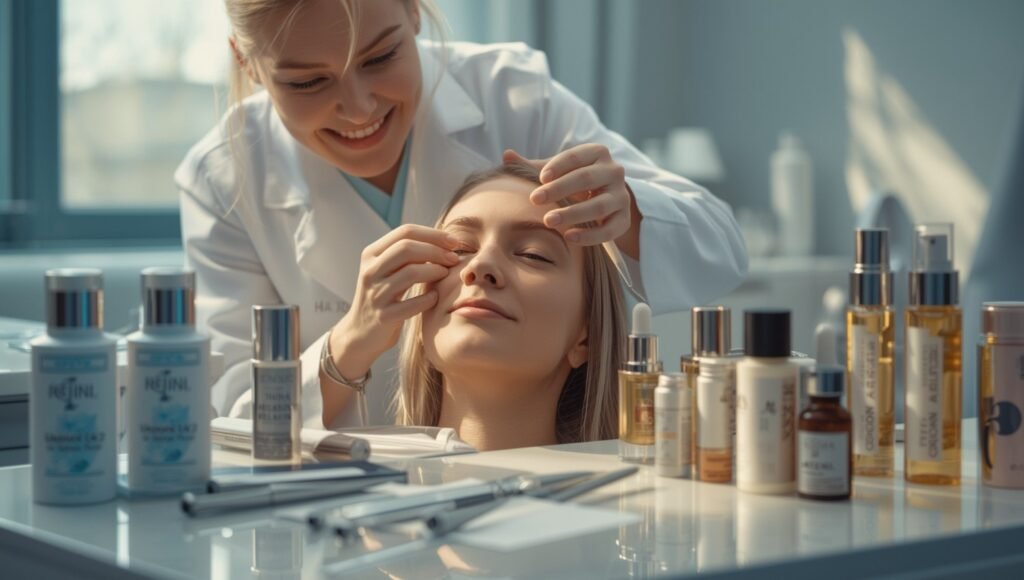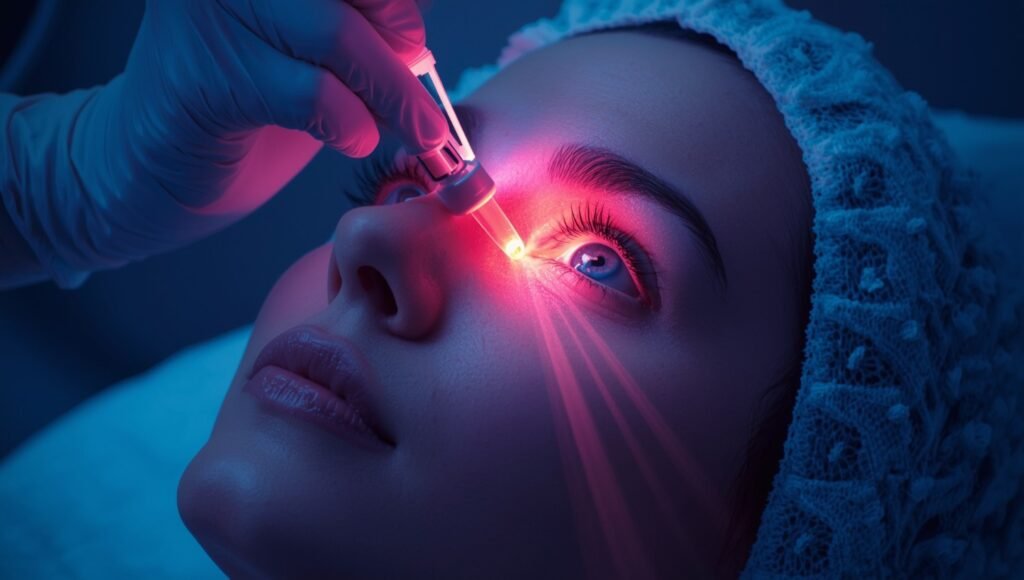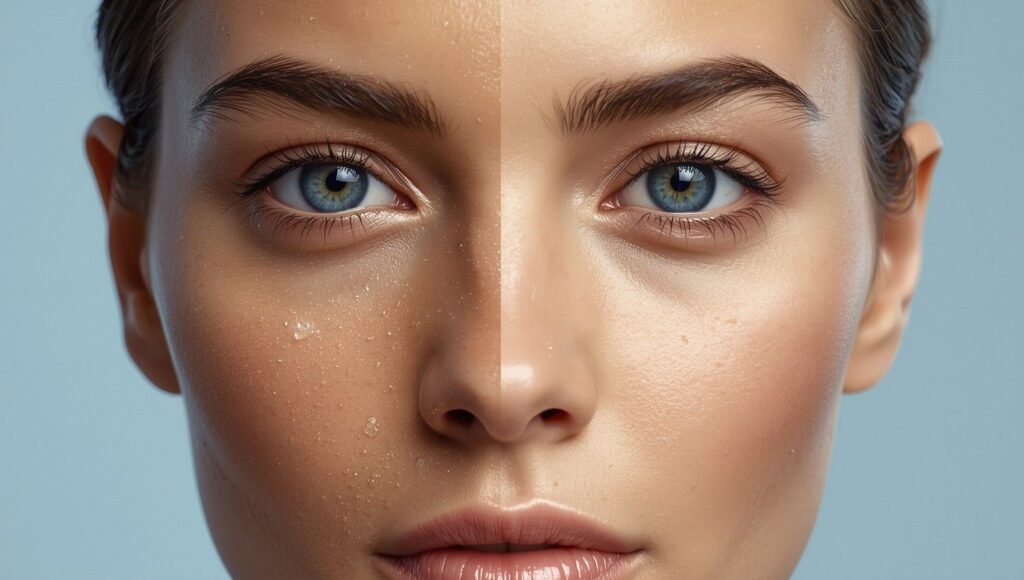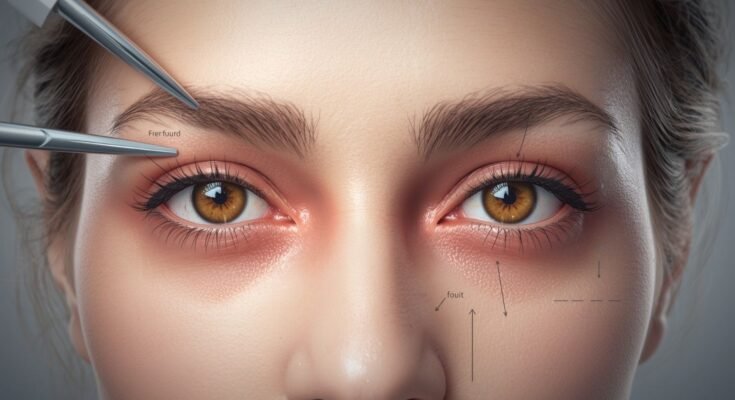Introduction
When I first noticed my under-eye bags, it wasn’t just about looking less youthful or less rested—it was how the appearance began to affect my quality of life. For many people across all ages, the causes are often a mix of sleep issues, stress, dietary habits, or even genetic traits passed down through families. These factors make the problem more pronounced during facial expressions, leaving a tired, sometimes aesthetically unappealing look. While the condition may seem temporary, for some it can turn permanent, with dark circles and puffiness becoming a common concern. From my own experience as well as working with others, I’ve seen how skin can become lax through ageing, sun exposure, or genetics, while excess fat pads in the lower eyelids further highlight the issue.
Practical Approaches and Professional Options
The good news is that there are both natural and practical approaches to reducing the look of eye bags, often without rushing to surgery. Simple lifestyle adjustments like better sleep, stress management, and mindful skincare routines can make a big difference in how the area looks and feels. I’ve tried professional skincare treatments, and they can be quite effective as supportive steps before exploring surgical options. For more persistent cases, cosmetic treatments like fillers or procedures targeting the lower eyelid can help eliminate puffiness, while more advanced methods, including surgery, remain a choice for individuals seeking a quick but lasting fix. These tailored treatments ensure that options exist for everyone, whether you want a gentle change in how your skin looks or a permanent solution to restore confidence.

What Causes Under-Eye Bags?
From my own journey and observing others, I’ve learned that under-eye bags don’t come from just one source—they’re often the result of a combination of factors. Sometimes it’s hyperpigmentation, fine or deep lines, or simple puffiness linked to weakened muscles, skin, and cells in the eyelid. As these delicate tissues begin to weaken, the fat and tissue that normally support the area can move downward into the lower area, creating that unwanted real estate beneath the eyes. Add in vascularity, dark or puffy shadows, and you have a common cause of that tired look many struggle with.
Lifestyle choices play a major role, too. Dehydration, high salt intake, smoking, or heavy drinking of alcohol can cause the body to retain water, leading to noticeable swelling. Seasonal allergies often trigger congestion and inflammation, while genetics make it a physical characteristic that runs in the family. The natural ageing process brings a gradual loss of firmness in the skin, so with time, you may lose elasticity and structure, making the bags more obvious. This mix of triggers explains why nearly everyone notices some degree of bagging under the eyes eventually.
How to Improve the Appearance of Under-Eye Bags at Home?
From personal experience, I know that not all under-eye bags are severe, and sometimes simple at-home remedies can help. By habitually using the right products and sticking to a routine, you can reduce puffiness within minutes. While not a cosmetic cure-all, these methods are affordable alternatives to surgery or other surgical paths. Many non-surgical treatments, like topical creams with retinol or hyaluronic acid, help firm the skin and ease puffiness. I often rely on cold compresses or even chilled tea bags for temporary relief from swelling. Pairing these with smart lifestyle changes—getting good sleep, staying hydrated, and managing salt intake—makes a real difference in controlling the severity. For more pronounced cases, even newer options like polynucleotide injections that stimulate collagen production can promote thickening and tightening of the lower eyelid area, providing an effective solution for mild issues without being too invasive.
Surgical Options to Get Rid of Under-Eye Bags
For those who want a permanent solution, specialists like Hyder Ridha at HR Plastic Surgery offer personalized surgical options for the lower eyelid bags. The most common is blepharoplasty, which may involve skin, muscle, or fat excision and sometimes repositioning of tissue to remove or redistribute bulk under the eyes. These surgical approaches are tailored to your needs and can deliver immediate and long-lasting results. Recovery time is typically short, and with an optimal treatment plan, each patient can expect a smooth outcome. During the consultation, your surgeon will assess and recommend the most appropriate approach for your goals, ensuring the solution is uniquely fitted to you.

What to Expect During Lower Eyelid Surgery?
A lower eyelid surgery generally lasts a few hours, depending on the complexity of the case. The procedure begins with preparation and either a local or a general anaesthetic. Once you’re numb and relaxed, the surgeon proceeds with incision placement, using small, discreet incisions along a natural crease or inside the lid, called a transconjunctival cut, to ensure minimal visible scarring. In some cases, fat grafting is added, where tissue is harvested from the body—such as the abdomen or thighs—then purified and injected into the area to restore volume, reduce hollows, and create a smoother, more youthful appearance.
During blepharoplasty, the surgeon may perform skin and muscle excision to remove excess tissue or correct a lax and aged appearance. Any weakness in ligaments that support the lower eyelid is managed by tightening areas of laxity. The surgeon carefully removes fat deposits that cause puffiness, especially for individuals with bulging bags. Where needed, repositioning addresses hollowing or unevenness, helping to create balance and correct volume loss. Once the desired changes are complete, incisions are meticulously closed with fine sutures. Though external scars may be visible in some, they are usually minimal. After the procedure, most patients experience bruising and swelling, which typically subsides in a few weeks, allowing individuals to return to normal activities with continued recovery progress.
Professional Treatments
When at-home remedies don’t deliver the expected results, more professional treatments can provide targeted solutions for stubborn under-eye bags. A dermal clinician can assess whether the issue is linked to puffiness, darkening of the skin, or a persistent problem that doesn’t respond to simple lifestyle changes. For many, seeking this kind of care not only improves physical comfort but also restores confidence and enhances daily life by reducing the constant discomfort that bags can bring.
Chemical Peels
Chemical peels are a popular cosmetic treatment designed to reduce the appearance of under-eye bags by removing the outer layers of damaged skin. By applying a special solution with acids that dissolve the top layer, the body is encouraged to generate new, healthy cells. This renewal process improves skin texture and tone, leaving the area smoother and more youthful underneath. Over time, this can stimulate collagen production, helping the skin to plump naturally.
Under-Eye Volumisation
Under-eye volumisation works by targeting fat pads beneath the eyes and dark circles that form underneath. This treatment uses hyaluronic acid, a natural substance in the body that attracts moisture to plump the skin. When administered directly to the area, the volumising filler can fill hollows, making the surface smoother. Patients often notice quick and comfortable results that last several months to a year. It can also help with mild laxity, fluid retention, or uneven pigmentation and tone, though it does not lighten certain areas affected by genetics.
Rejuran
Rejuran is a skin healing treatment made from polynucleotides, which are DNA fragments that help repair and regenerate tissue. Applied to the under-eye area, it improves thickness, elasticity, and hydration while softening fine lines and reducing puffiness. By stimulating the natural healing process, Rejuran is particularly effective for improving overall quality in the delicate eye region.
Ultraformer MPT
The Ultraformer MPT is a non-invasive ultrasound treatment that delivers precise results for under-eye concerns. It uses focused energy directed into deeper skin layers to stimulate collagen production. The outcome is a firmer, brighter appearance with no downtime, making it an appealing option for patients who prefer a subtle, yet effective approach.
Laser or LED Therapy
Laser and LED treatments rely on specific wavelengths of light to stimulate cellular repair and boost collagen production in the delicate under-eye area. These therapies can improve skin texture, reduce puffiness, and enhance overall quality. Because they are gentle and comfortable, they can be combined with other treatments for a comprehensive plan.
The Two Types of Laser Treatments Recommended for Under-Eye Bags
Fraxel resurfacing laser uses non-ablative technology to encourage collagen production and remodelling. It improves hollow under-eyes, fine lines, laxity, and superficial pigmentation, helping to brighten the area.
The Picoway treatment can be customised to target deeper shadowing and pigmentation. By promoting both collagen and elastin production, it enhances firmness and overall quality, improving the skin around the eyes.

How to Eliminate Under-Eye Bags?
What are bags under the eyes?
Under-eye bags are essentially the accumulation of fat in the lower eyelids. Over time, weakened skin begins to relax, creating an aesthetic problem. While often non-pathological, they remain a concern due to their appearance and impact on daily life. For many, these bags develop gradually, becoming both a daily and long-term aesthetic challenge.
What are the causes?
Les causes des poches sous les yeux sont nombreuses et peuvent se combiner. Genetic predisposition is one of the most determining factors in the formation of under-eye bags. Individuals with a family history may face this issue at an earlier age, but lifestyle influences also play a role.
- Sleep irregularity: Without adequate sleep, health and skin beauty suffer. Insufficient or poor quality rest disrupts recovery processes, causing edema around the sensitive eye area and encouraging the formation of bags.
- Dietary habits: Unhealthy habits like alcohol consumption, excessive salt intake, and smoking increase water retention, making skin swell and promoting the formation of under-eye bags.
- Allergic reactions: Allergic reactions create sensitivity around the eyes, leading to swelling and worsening the appearance of bags.
- Lymphatic circulation disorders: When the lymphatic system fails to properly move fluids through the body, accumulation and edema occur. This contributes to the formation and bagging of the eyes.
Other reasons include genetic predisposition causing puffiness in sensitive skin, natural aging with loss of fatty tissue, collagen, elasticity, and tone, and diseases such as thyroid issues, infections, allergies, stress, and smoking, all of which impact the appearance of bags under the eyes.

Why Do Under-Eye Bags Become More Pronounced When You Smile?
Under-eye bags can appear more obvious during facial expressions. Muscles in the face activate, contract, or loosen with laughter, stretching thin, sensitive skin around the eyes. With smiling, these bags become pronounced, especially when elasticity is reduced and fat tissue loses support. Conditions like insomnia or stress add to the appearance, and poor lifestyle changes only increase the impact.
What are the consequences?
Persistent bags under the eyes are more than just an aesthetic problem. They contribute to a tired, aged look and can be linked to underlying medical conditions. A dermatologist should be consulted if symptoms appear to rule out any hypothesis of deeper health concerns.
What are the 3 types of under-eye bags?
There are three main kinds, depending on the excess fat compartments in the lower eyelid. Each pack can be affected differently, influencing the appearance of bags and sometimes requiring surgery.
When should you seek medical advice?
If you notice swelling that becomes painful, red, or itchy, see a dermatologist for a proper diagnosis. While usually cosmetic, these changes may indicate a medical issue.
How can I prevent bags under the eyes?
To prevent under-eye bags, focus on both internal and external factors. If aging or genetic traits are the cause, cosmetic surgery might be the strongest option. Otherwise, small tips can reduce their appearance: eat healthy foods, manage salt, control stress, and aim for eight hours of sleep with your head elevated. Try cool and moist compresses for swelling, cosmeceuticals to conceal dark circles, or even haemorrhoid creams to tighten blood vessels under the eyes.
What kind of surgery is needed to eliminate bags?
Blepharoplasty is the most common cosmetic eyelid surgery. It smoothes and tightens the skin of the lower eyelids by removing fatty tissue with precise incisions. It can also treat drooping upper lids. Performed outpatient under local anaesthetic, it delivers excellent results, though each patient has unique expectations and effects.
Recovering from surgery
Recovery requires care after surgery. Use cold compresses, apply eye drops to avoid infection, and wear sun cream with sunglasses to protect the delicate area. While rare, risks include bleeding, bruising, infections, numbness, touch sensitivity, skin discoloration, or cysts. If symptoms arise post-op, consult your doctor immediately.
How to Reduce Under-Eye Bags That Appear When Smiling?
If under-eye bags are only noticeable during facial expressions and fade at rest, the issue may be linked to weakened elasticity. Immediate relief can improve their appearance, while consistent care ensures benefits in the long term.
- Short-Term Solutions: Apply ice packs, cold tea, or soothing skin creams with caffeine, peptides, and vitamin C to boost circulation and reduce puffiness. A gentle massage with anti-inflammatory effects can ease tissue congestion under the eyes.
- Lifestyle Changes: Focus on regular, quality sleep, limit salt and alcohol intake, stay hydrated, and protect skin with sunblock. Avoid rubbing the sensitive skin, which can irritate and worsen bagging.
- Medical Aesthetic Applications: Light filler, laser treatments, or mesotherapy and PRP can restore volume, improve collagen production, and rejuvenate the tissue by supporting blood circulation and renewal.
When Is Under-Eye Bag Surgery Necessary?
When aging leads to under-eye bags that stay visible even at a neutral facial expression, both aesthetic and medical concerns arise. Non-invasive methods may help, but if results are unsatisfactory, surgical intervention is an option. Lower blepharoplasty involves the removal of fat and skin tissue under anesthesia, tailored to each patient’s comfort. It provides a permanent, natural look. After the post-operative stage, daily activities like exercising, work, and social routines can resume. Following your doctor’s advice ensures a smoother recovery and speeds up the process.

Frequently Asked Questions
Do under-eye bags increase with age?
Yes. As the skin ages, elasticity decreases and muscle tissue weakens, letting fat push outward.
Can under-eye bags that become more noticeable when smiling become permanent?
Yes, they can. If elasticity decreases, temporary smile-related bags may become permanent.
What can be done at home for under-eye bags?
Cold tea bags, cucumber slices, and caffeinated eye creams offer short-term relief. Long-term improvement requires healthy sleep, diet, and professional care.
Which vitamin deficiency causes under-eye bags?
No single vitamin causes them, but low Vitamin C or B12 may worsen puffiness or darkening. Balanced nutrition and supplements help reduce risks.
Will lower eyelid surgery remove excess skin and eliminate bags under my eyes?
Yes. Lower eyelid surgery effectively removes excess skin and reduces puffiness, creating a smoother, youthful appearance.
Can I combine upper and lower eyelid surgery to address both areas?
Yes. Many patients choose to combine both surgeries for optimal results. This approach treats excess skin in the upper eyelids and puffiness under the eyes, achieving a more balanced, refreshed look.
How long does it take to recover from lower eyelid surgery?
Most patients return to regular activities within one week. Swelling and bruising are common but typically resolve in a few weeks. Following your surgeon’s recovery instructions ensures the best outcome.
What are the risks of lower eyelid surgery?
As with any surgery, risks include infection, scarring, or temporary blurred vision. Performed by an experienced surgeon, the risks are minimal and recovery is usually smooth.
Is cosmetic eyelid surgery the best option for treating lower eyelid bags?
Yes. Cosmetic eyelid surgery, known as blepharoplasty, is the most effective long-term solution for under-eye puffiness. Non-surgical treatments may provide partial or temporary improvements, but blepharoplasty delivers lasting results.
Can lower eyelid surgery cause watery eyes?
Some patients may temporarily experience watery eyes due to swelling or tear duct changes. This effect usually subsides during healing.




